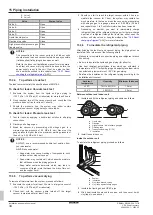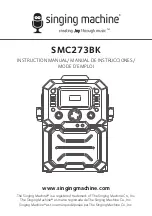
9 Relocation
Installation and operation manual
19
REMA5+REYA8~20A7Y1B
VRV 5 heat recovery
4P684060-1 – 2022.02
▪ A "pishi-pishi" squeaking sound is heard when the system stops
after heating operation. Expansion and contraction of plastic parts
caused by temperature change make this noise.
▪ A low "sah", "choro-choro" sound is heard while the indoor unit is
stopped. When another indoor unit is in operation, this noise is
heard. In order to prevent oil and refrigerant from remaining in the
system, a small amount of refrigerant is kept flowing.
8.2.9
Symptom: Noise of air conditioners
(Indoor unit, outdoor unit)
▪ A continuous low hissing sound is heard when the system is in
cooling or defrost operation. This is the sound of refrigerant gas
flowing through both indoor and outdoor units.
▪ A hissing sound which is heard at the start or immediately after
stopping operation or defrost operation. This is the noise of
refrigerant caused by flow stop or flow change.
8.2.10
Symptom: Noise of air conditioners
(Outdoor unit)
When the tone of operating noise changes. This noise is caused by
the change of frequency.
8.2.11
Symptom: Dust comes out of the unit
When the unit is used for the first time in a long time. This is
because dust has gotten into the unit.
8.2.12
Symptom: The units can give off odours
The unit can absorb the smell of rooms, furniture, cigarettes, etc.,
and then emit it again.
8.2.13
Symptom: The outdoor unit fan does not
spin
During operation. The speed of the fan is controlled in order to
optimise product operation.
8.2.14
Symptom: The display shows "88"
This is the case immediately after the main power supply switch is
turned on and means that the user interface is in normal condition.
This continues for 1 minute.
8.2.15
Symptom: The compressor in the outdoor
unit does not stop after a short heating
operation
This is to prevent refrigerant from remaining in the compressor. The
unit will stop after 5 to 10 minutes.
8.2.16
Symptom: The inside of an outdoor unit is
warm even when the unit has stopped
This is because the crankcase heater is warming the compressor so
that the compressor can start smoothly.
8.2.17
Symptom: Hot air can be felt when the
indoor unit is stopped
Several different indoor units are being run on the same system.
When another unit is running, some refrigerant will still flow through
the unit.
9
Relocation
Contact your dealer for removing and reinstalling the total unit.
Moving units requires technical expertise.
10
Disposal
This unit uses hydrofluorocarbon. Contact your dealer when
discarding this unit. It is required by law to collect, transport and
discard the refrigerant in accordance with the "hydrofluorocarbon
collection and destruction" regulations.
NOTICE
Do NOT try to dismantle the system yourself: dismantling
of the system, treatment of the refrigerant, oil and other
parts MUST comply with applicable legislation. Units
MUST be treated at a specialised treatment facility for
reuse, recycling and recovery.
10.1
Eco Design requirements
Follow the steps below to consult the Energy Label – Lot 21 data of
the unit and outdoor/indoor combinations.
1
Open the following webpage:
https://energylabel.daikin.eu/
2
To continue, choose:
▪ "Continue to Europe" for the international website.
▪ "Other country" for a country related site.
Result:
You are directed to the "Seasonal efficiency" webpage.
3
Under "Eco Design – Ener LOT 21", click "Generate your data".
Result:
You are directed to the "Seasonal efficiency (LOT 21)"
webpage.
4
Follow the instructions on the webpage to select the correct
unit.
Result:
When the selection is done, the LOT 21 datasheet can be
viewed as a PDF or a HTML webpage.
INFORMATION
Other documents (e.g. manuals, ...) can also be consulted
from the resulting webpage.
















































